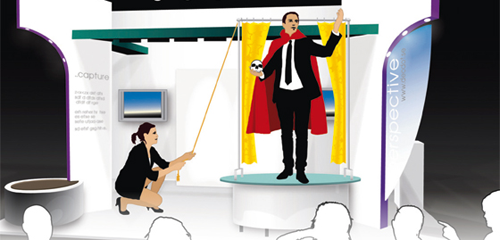
Dramatize more
Creating a narrative around your product allows you to generate greater interest and relevance. The Swedish branding agency Rewir’s Creative Director, Olle Nyström, an expert on events and meetings, suggests four tricks you can use.
1. Meeting visitors at their level
It’s 10am and visitors are queueing to get in; as an exhibitor, you’re supercharged and want to give it all you’ve got. But visitors are often in another place mentally; they wander around rather aimlessly without knowing exactly what they’re after. At the same time, taking part in an exhibition has many benefits as visitors will have a general interest in the theme and have paid to get in.
Olle suggests: – Exhibitors and visitors need to meet each other halfway. Instead of launching straight in to your product’s or service’s solution, try to envisage the visitor’s mental state, why they are here, what their goals and needs are. You need to relate to the visitor. If your stand makes a relevant impression, your chances of a productive conversation will increase. You will frequently find relevance in Step One: The visitor’s problems, needs or desires.
2. Creating context
At food and drink fairs, you can often sample one product together with another: a cheese and a wine, waffles and jam, etc. You can use the same technique to create a connection with your product, i.e. display it in a certain context.
Olle suggests: – You can show how the items interact and create a universe around your product.
3. Designing your stand correctly
Creating a narrative doesn’t mean that you have to design your stand as a corridor where the visitor views items in a set sequence. It’s more about how you display your solution, the context you choose and the images you convey as a result. If you sell reading chairs, you could create a home library with a fireplace and Vivaldi playing softly to convey the peace of mind the visitors will experience when they sink down in the chair.
Olle suggests: – Obviously you’ll want to display your product, but it’s often more relevant to show what the visitor can achieve with your product, what problem it solves or which need it satisfies. If you’re able to create a narrative and dramatize it, the visitor will leave in possession of a story. There is nothing that affects us as deeply, and that’s what you want to achieve.
4. Considering the consequences
Once you’ve led your visitors through Step One and then shown your brilliant solution in Step Two, you’re on the home stretch. This is about sealing the deal and taking care of any questions that may arise. If you’re selling a yacht for two million SEK, you could coordinate with a banker to arrange financing, a trailer supplier to transport the yacht home or a marina where the visitor can berth it.
Olle suggests: – Try to be prepared for the consequences that the purchase of your solution may involve.
Creating a narrative allows you to involve the visitor in your story. In its simplest form, you can divide it into three steps, known as the dramaturgic line. This is frequently about a problem (need, preference, longing), a solution and a consequence in which the loose ends are tied together or new questions that arise are answered. For a charter company, the dramaturgic line might look like this:
•Need – we are reminded of a beach, a beach umbrella and a book. We begin to feel a longing to get away and “need” a relaxing holiday trip.
•Solution – a plane journey to the destination.
•Consequence – the company has arranged a hotel, guided tours, child minding or a cookery course at the destination.
“Just shouting out “Majorca 4,999 SEK” would be leaving out the all-important first step. Talking to the visitor and finding out about what they want and desire - their motivation - increases the likelihood of having a rewarding conversation with that person. Then you can present your solution in a relevant way,” explains Olle Nyström.
a